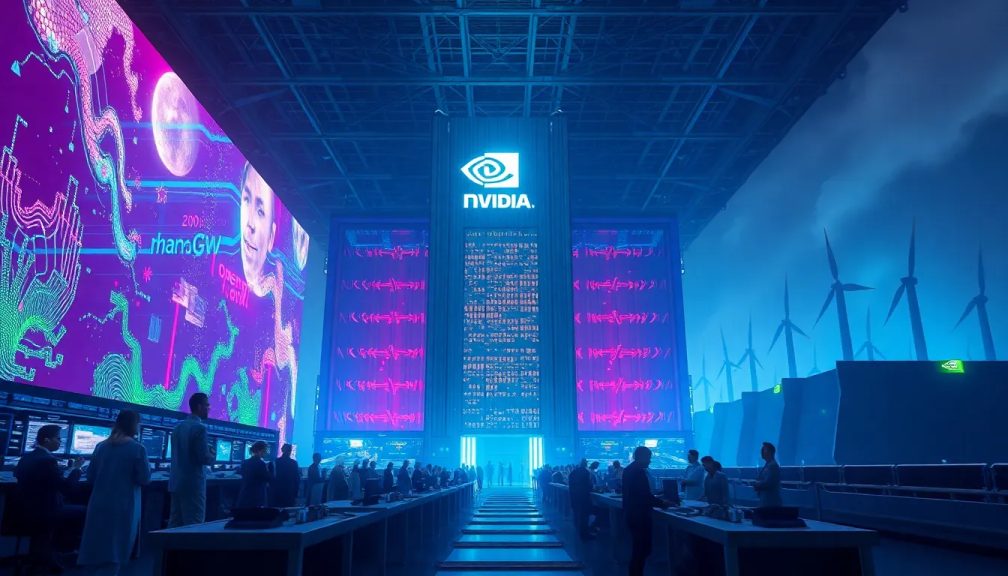NVIDIA invests $100 billion in OpenAI to deploy 10GW technology

In a groundbreaking announcement, NVIDIA has revealed plans to invest a staggering $100 billion in OpenAI while OpenAI commits to deploying a significant amount of NVIDIA's computational resources. This strategic partnership marks a pivotal moment in the evolution of AI technology, with both companies poised to reshape the industry landscape.
The scale of this deal is immense, not just in terms of financial investment but also in its potential impact on AI infrastructure and capabilities. As the world increasingly turns towards AI-driven solutions, this collaboration places NVIDIA at the forefront of next-generation hardware provision for OpenAI, securing its position amid evolving technological demands.
NVIDIA and OpenAI: A Strategic Partnership
The recent deal between NVIDIA and OpenAI signals a deeper collaboration, where the former will not only invest in OpenAI but will also be integral to its computational architecture. This relationship is particularly noteworthy given the speculation that OpenAI might have shifted towards different computational solutions in the future.
As outlined in the announcement, NVIDIA is committed to investing up to $100 billion to support OpenAI's deployment, which includes enhancing data center capabilities and increasing power capacity. This investment is expected to roll out in tandem with new NVIDIA systems, specifically targeting a launch in the second half of 2026.
The first phase will leverage the NVIDIA Vera Rubin platform, which represents a significant advancement in computational architecture. This new platform will incorporate NVIDIA’s custom Arm core technology alongside the upcoming Rubin GPU, the successor to the Blackwell series. Such innovations position NVIDIA to compete vigorously with industry giants like AMD and Intel.
Understanding the Investment Structure
It's crucial to note that the $100 billion investment is not a lump sum provided immediately. Instead, it will be allocated progressively as NVIDIA deploys its new systems. This approach deviates from traditional vendor financing models. NVIDIA appears to be opting for an equity investment, effectively allowing OpenAI to fund its infrastructure while integrating NVIDIA's advanced computing resources.
This unique financial arrangement reflects a broader trend in the tech industry, where partnerships are increasingly characterized by equity stakes and collaborative growth rather than straightforward transactions. This model allows for shared risks and rewards, fostering innovation and strategic alignment.
The Role of Networking in AI Infrastructure
Another significant aspect of this partnership is the emphasis on networking capabilities. NVIDIA will serve as a preferred strategic partner not only for computational needs but also for networking solutions as OpenAI expands its AI factory operations.
- NVIDIA dominates the AI server NIC market, which is crucial for optimizing performance and connectivity in AI applications.
- For every GPU deployed, AI servers typically require $1,000 to $3,000 in networking and connectivity components.
- The introduction of powerful networking solutions, such as the NVIDIA SN5610 switch, offers advanced capabilities, including 64-port 800GbE configurations.
These networking investments are not merely supplementary; they are integral to maximizing the efficiency and scalability of AI applications. The right networking infrastructure ensures that AI systems can handle vast data flows and processing demands, which is essential as the industry moves towards more complex AI models and applications.
What is an AI Factory?
In the context of this partnership, both companies refer to OpenAI’s growth strategies as an “AI factory.” This term has garnered attention, yet its definition seems to vary across the industry. Understanding what constitutes an AI factory is crucial for grasping the full implications of this partnership.
- An AI factory typically encompasses a robust infrastructure designed to facilitate the development, training, and deployment of AI models.
- This infrastructure includes high-performance computing resources, data management systems, and integrated networking solutions.
- The goal is to optimize the AI development lifecycle, enabling rapid experimentation and deployment of models in real-world applications.
A deeper exploration of what an AI factory entails can be found in discussions among industry experts and thought leaders, reflecting a growing interest in standardized approaches to AI development.
The Future of AI Infrastructure Investments
The investment landscape for AI infrastructure is witnessing a significant shift. Major hardware providers are increasingly stepping up to build AI clusters, recognizing the need for substantial capital to support these ambitious projects. This trend indicates a future where:
- Capital investments are sourced from equity financing, allowing for greater flexibility and alignment between partners.
- Infrastructure capabilities are expanding rapidly in response to growing demands for AI processing power.
- Companies are striving to create sustainable and scalable models to meet the demands of AI technology.
The commitment to deploying 10GW of power underscores the monumental scale at which major AI firms are operating. In an era where building 1GW facilities is becoming the norm, the ambitions represented by this partnership signify a substantial leap forward.
As NVIDIA and OpenAI forge ahead with this strategic collaboration, the implications for the AI sector are profound. Not only does this partnership set the stage for groundbreaking advancements in AI technology, but it also exemplifies the evolving dynamics of collaboration and investment within the tech industry.
For those interested in a visual overview of these developments, a related video discussing NVIDIA's economic impact on tech stocks can provide additional insights:




Leave a Reply